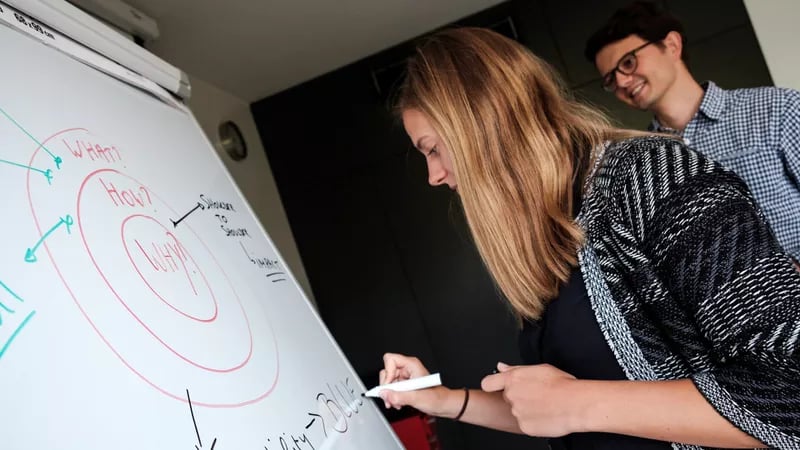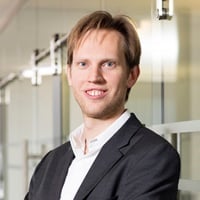Conscientious consumers, ambitious European plans, and the global scarcity of raw materials are turbocharging the circular economy. Helen Versluys and Mathias Fahy, experts at consultancy firm Möbius, help guide companies in different value chains to develop new circular models. These companies face a complex challenge because they must reconcile cutting-edge technological innovation with social innovation. “Every social transition takes about 30 years. The circular transition is still in the emergent phase, but truly seems underway now.”
Helen Versluys believes that the circular economy is at a tipping point today. “Both Mathias and I have been around for a while. There’s been talk for more than a decade of the great breakthrough of the circular economy. In reality, the share of the linear economy is still growing at the expense of the circular economy. However, we are now starting to see a change. Start-ups and pioneering companies in different sectors are experimenting and innovating with new circular models. The circular transition has really taken off now. There’s still lots of work to do, but the train has left the station. We don't talk now, we act.”
"The circular transition has really taken off now. There’s still lots of work to do, but the train has left the station."
“The European Union's Green Deal is a significant driving force. Europe's ambition is climate neutrality by 2050. A huge amount of the work needed must still take place in the next eight years between now and 2030. The circular economy is one of the spearheads of the Green Deal. Most people think that reducing CO2 emissions relates only to energy, transport, solar panels, wind turbines, and electric vehicles. However, 45 percent of emissions are embedded in the actual materials and products, such as building materials, clothing, or electronic equipment. To put it bluntly, we will not achieve our climate objectives solely with the energy transition. The circular transition may offer a solution.”
Making products last longer
The circular economy is more than just recycling in a new guise, emphasises Mathias Fahy.“We need to move from just recycling to the inner circles of the circular economy. Today, Flanders is among the European pioneers when it comes to the selective collection of waste and recycling. For instance, we recycle 90 percent of all of our construction waste. The problem is that the recycled material is often low-quality material, which is only suitable for low-value applications. For example, we recycle many high-quality PET bottles into household rubbish bags. It’s better than nothing, but that need means we need new raw materials, of course.”

“Recycling and reuse are an essential part of the circular economy. But there is a growing awareness that we need to start closing the materials and products loop much earlier. Extending lifespan is paramount. How do we ensure that products last longer and are also used as such? Often this starts with the design, assembling products in a manner that makes them easier to disassemble, repair, or reuse the different parts. With lighting, crucial elements are often hidden deep within the product, making them very difficult to repair. You see this with many products. Office chairs are often of complex design with a mix of different materials. So, they do not fit at all well into a circular economy. In the kitchen, you see new packaging popping up that is half cardboard and half paper. They may look ecological. But the mix of materials means these are not sortable or recyclable, let alone reusable."
"How do we ensure that products last longer and are also used as such? Often this starts with the design, assembling products in a manner that makes them easier to disassemble, repair, or reuse the different parts."
“Companies feel increasing pressure, both from consumers and governments. They have to meet higher product standards. Europe is taking the lead in this evolution with initiatives like the right to repair that force companies to make repairable products. You still see a stubborn lobby working against stricter standards. Yet more and more companies are realizing that they must go circular to achieve their climate objectives.”
Technological and social innovation
Versluys believes the stars must align right to accelerate the circular economy. “The focus is often cutting-edge technology. While this is necessary, social innovation is just as important as technological innovation. Why are clothing libraries not breaking through? Because buying and owning things is embedded in our DNA, especially clothes. But we’re gradually seeing a change in behaviour, away from ownership. For instance, car or bike sharing. Nonetheless, social innovation is a complex and slow process.”
"We’re gradually seeing a change in behaviour, away from ownership. For instance, car or bike sharing."
“The construction sector is a good example. It would significantly help the circular transition if we built things in a standardised way. But if you look at any street in Flanders, you find country-style houses next to ultra-modern villas. That’s why it’s difficult to close the loop and reuse materials. You can't just take a country-style house window and pop it into a modern house. Currently, very little is being built in Flanders with a view to change. We weld or glue everything together. And yet, change-oriented construction offers so many advantages. A building that can adapt with a few minor interventions to changing needs and expectations of the occupant or users to satisfy their new situation reduces consumption of raw materials and waste streams. To build in a standardised and change-oriented way, you must involve all links in the chain, the architect, property developer, contractor, demolition company, the occupant, of course… everyone must be persuaded.”
27.000 new jobs
Möbius helps companies, such as Bpost Future Lab and Barco, to experiment with new circular business models. “We want to make an impact and we are bridge builders. The two pillars of Möbius's purpose unite in the circular economy. This challenge suits us to a T. Many actors must join hands for the circular economy to succeed. They must all cross a threshold, the consumers, companies, authorities, as well as banks and other investors. As a neutral facilitator, we support and encourage collaborations beyond the boundaries of sectors or public-private players.”

Versluys and Fahy are optimistic about the future of the circular economy despite the obstacles that still stand in the way. “Research shows that the circular transition provides lots of opportunities to create new locally based jobs. According to the KU Leuven, this may provide as many as 27,000 jobs just in Belgium. There are many, many opportunities for companies. Europe is freeing up lots of resources for circular models and is launching a whole battery of calls for projects to give companies a boost. The government has powerful leverage in its hands. About 15 percent of all expenditures in Belgium are public. If part of that public spending – that the government must do anyway – is reserved for circular products, Belgium can turbocharge the circular transition at no additional cost.”
"Research shows that the circular transition provides lots of opportunities to create new locally based jobs. In Belgium alone, 27,000 jobs may be at stake."
A transition takes 30 years
“The scarcity of raw materials can be an additional driver. When virgin raw materials are no longer available or affordable, the circular economy is the only alternative. Companies are already getting nervous. They see that raw materials are increasingly scarce and pricier, and regulations are increasingly stricter requiring a certain amount of recycled raw materials. The demand for recycled material will increase, so the supply must also rise. We need more recycled raw materials of a higher quality. We need to rethink the whole chain from product design and development to reverse logistics, so we get all the raw materials back to where we first took them from.”
“It’s a complex challenge, but we can beat it. Every transition takes about 30 years. The circular transition is still in the emergent phase, but truly seems underway now.”
This article is a collaboration between Bloovi Studio & Möbius. The original article can be found here.



